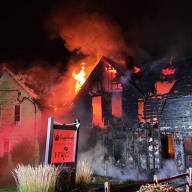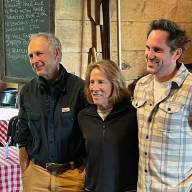Brigid Nease, outgoing superintendent of the Harwood Unified Union School District (HUUSD), is proud of her tenure and what she and her team accomplished in 13 years. When she spoke to The Valley Reporter, she was clear-eyed and candid about those successes and the challenges she and the district faced during that time.
Here are some bullet points.
-Act 46 was an unmitigated disaster for the school district and the Legislature abandoned school districts once it passed.
-Nease’s community negotiation model changed how teacher/staff contracts were developed, saving the district $60,000-$65,000 a year in attorney’s fees.
-Nease wishes she’d pushed back on the school board’s model for taking public comment and wishes she’d pushed back even more and held her own community dialog sessions.
-Like everyone in the community, the October 2016 car crash that claimed the lives of five local teenagers, was one of the hardest things she experienced and something she had to lead through to help her students and staff.
Read on for The Valley Reporter’s Q and A with Nease. This is part one of a two-part series.
JOINED DISTRICT IN 2009
Nease is leaving the district at the end of this month. She joined the school district in 2009 after the district had undergone a long period of instability. During the interview, The Valley Reporter raised the issue of that instability and Nease was prepared with data points.
“From 1985 when Bill Lincoln left until I came in 2009, there were 11 superintendent changes in 24 years. There were some interim superintendents and Dick Moser was here twice. I’m the longest-serving superintendent that the district has ever had and the only female superintendent,” Nease said.
Asked what attracted her to what was then the Washington West Supervisory Union, Nease said former superintendent Bob McNamara recruited her. At the time she had just finished her 20th year as principal at the Johnson Elementary School. Her kids were grown and out of the house.
“Back in those days, there were seven boards in the district and they met twice a month for 14 meetings a month out of 20 weekdays a month,” she recalled.
Nease, who lives in Underhill, did a lot of late-night driving after those meetings.
Valley Reporter: What goals did you have when you first started here?
Nease: “The district was in disarray. It was only natural that it would be with that much turnover. I took my lead from the Washington West board. I remember vividly a retreat we had at the old Small Dog building where we locked up for about seven hours, they explained to me what they thought their challenges and needs were and what needed attention and we did collaborative goal setting. The board emphasized the need for accountability at the student level through the teacher level.
They wanted teacher evaluation process that was authentic and that had a quality control element built into that that was enforced and overseen in a way that required for all and was formative in nature and would help teachers grow and improve. They wanted strong policy work. In 2009, last year policy revision was in 1993. The policies were seriously out of date.”
Nease said that that early work was successful and she noted that the Washington West executive committee was a high-functioning board which provided a good systemic structural tool to keep people informed. The board was highly collaborative and met once or twice a month as necessary.
ACT 46 TRANSITION
Valley Reporter: The transition from and to Act 46 must have been astonishing.
Nease: You know what? It was horrendous and I think, with hindsight – we all love hindsight because you can be so wise with those reflections – I think it was a disaster is what I would say. I think people maybe knew it was dysfunctional and broken and that something wasn’t really right. Yes, I’m a little jaded because I became a scapegoat for a whole lot of things that, in my opinion weren’t on my shoulders.
Valley Reporter: We didn't know that, that it was such a disaster. Tell us more.
Nease: Think about this, you’re a superintendent and have really, healthy good, strong relationships with all seven boards. I think that was the truth. It was going swimmingly well. It was a friendly collaborative respectful situation. And then that all went away. A lot of the disaster [of Act 46] built from the lack of the structures and tools that became ineffective. Looking back, my experience was that the board was culturally and politically divided. They quickly established themselves as an A team and a B team and I was stuck in a vice grip of a tug of war game. I felt like A was yanking one way and B the other. That is also evidenced by the turnover. The 14-member board survived for the first year, 2017-2018. By 2018 things were tumultuous. People were not seeing eye-to-eye. People started to leave the board by March 2019 and continued to do so. In three years, 24 board members left the board.
Valley Reporter: Why was that? Was Act 46 architecturally flawed?
Nease: The tenets of Act 46 and what became the work of the Act 46 study committee somehow got misinterpreted. Communication was not really healthy around that time and the communication nightmare started and there was no way to pull that back. The second thing we could say with fidelity now is that the Legislature abandoned Act 46. They should have continued on their mission whether people agreed with that mission or not. So many people that voluntarily merged voted in very high percentages - like our district. There should have been a way to collaborate, communicate and compromise to come on to the other side and achieve something. But it was as if the state and Legislature acted like it never happened. And the people that were left in local towns were just struggling to communicate and set the goals and make it work and boards became contentious. Not just ours but many boards and in some cases they became toxic.
Nease noted with an A team and B team pulling in opposite directions and with 50% of people mad at her on any given day and the constant board turnover, making progress was difficult.
LIGHTNING ROD
Valley Reporter: You became a lightning rod.
Nease: Yes, I think if I could figure out a way to do it all over again I certainly would have done things differently and communication would have been first and foremost because the amount of time that things were just blatantly false or miscommunicated and the record never able to be corrected because of paths that we chose or board leadership chose. It didn’t serve the communities and didn’t get us ahead in the way that people wanted it to.
Valley Reporter: Act 46 was not a high point.
Nease: When I came in 2009 and now as I’m leaving, I’m saying the same message. I think this district has incredible untapped capacity and in order to reach those state-of-the-art untapped capacities, we have to be willing to change and do things differently. I’m not sure why we haven’t been able to market and sell that in a way that people understand it so that we could do many more state-of-the-art, creative new and different endeavors in this district. I in order to do that, we’ve got to be able to make some trades, make some compromises and really take a structural look at the district and make hard choices along the way. I leave sad. I leave sad for a number of reasons but most important is financial stress that I think we’re in right now, some by our hands, some not by our hands. I’m wishing and hoping and trying to do everything I can to set up [new superintendent Mike Leichliter] Mike in a way to succeed.
“Yes, I became a lightning rod. And when I look back on it, I can also say, from a leadership perspective, it’s not the only time a superintendent is a lightning rod in a community but as long as I had that role, I was that person that they could be mad at and it was a pass for not getting those problems solved and not taking advantage of the five years of tax incentives and building a long game around how we’d weather these financial pieces that are coming our way.
Hopefully, next leadership with new energy around the school board will be able to sit around and define what was the problem. It’s like a plant; if your plant is dying and you’re giving it more light or water or fertilizer but your plant has root rot, you’re not going to save your plant. So, if it is Act 46 and certain tenets of Act 46 are just never going to be palatable and workable for this district, then get out of it. Figure out a way to get out of it. It has never worked for us. It’s not gotten us financially where we want to get. We were not able to redesign or recreate the district in a way that offered more to kids and we always wanted to offer more to kids in terms of clubs, extracurricular. We wanted night classes. All those hopes and dreams were very much real. Things got twisted up along those lines and I think that it does stand out. It’s not just the superintendent. You could have the crappiest super in the world but the reality is that you don't lose 24 board members in three years. That’s about something else.
Next week The Valley Reporter will publish the second part of this exit interview with Nease where she reflects on the October 2016 crash that claimed the lives of five local students, the district response to COVID-19, how things might have been done differently after Act 46 consolidation and final thoughts.












